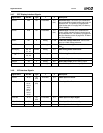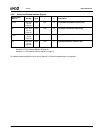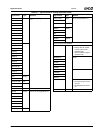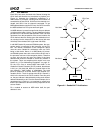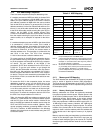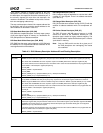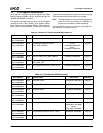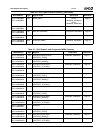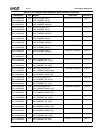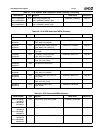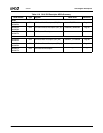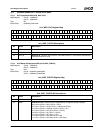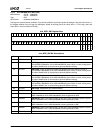
AMD Geode™ LX Processors Data Book 49
GeodeLink™ Interface Unit
33234H
4.1.3.2 I/O Routing and Translation
I/O addresses are routed and are never translated. I/O
request routing is performed with a choice of two descriptor
types. Each GLIU may have any number of each descriptor
type. The IOD types satisfy different needs for various soft-
ware models.
Each I/O request is compared against all the IOD. If the I/O
request does not hit in any of the descriptors, the request is
sent to the subtractive port. If the I/O request hits more
than one descriptor, the results are undefined. Software
must provide a consistent non-overlapping I/O address
map. The methods of check and routing are described in
Table 4-4.
IOD Base Mask Descriptors (IOD_BM)
IOD_BM is the simplest descriptor. It usually maps a power
of two size aligned region of I/O to a destination ID.
IOD Swiss Cheese Descriptors (IOD_SC)
The IOD_SC maps an 8-byte region of memory in 1 byte
chunks to one of two devices. The descriptor type is useful
for legacy address mapping. The Swiss cheese feature
implies that the descriptor is used to “poke holes” in I/O.
4.1.3.3 Special Cycles
PCI special cycles are performed using I/O writes and set-
ting the BIZARRO flag in the write request. The BIZARRO
flag is treated as an additional address bit, providing
unaliased I/O address. The I/O descriptors are set up to
route the special cycles to the appropriate device (i.e.,
GLCP, GLPCI, etc.). The I/O descriptors are configured to
default to the appropriate device on reset. The PCI special
cycles are mapped as:
Name BIZZARO Address
Shutdown 1 00000000h
Halt 1 00000001h
x86 specific 1 00000002h
0003h-FFFFh 1 00000002h-0000FFFFh
Table 4-4. GLIU I/O Descriptor Address Hit and Routing Description
Descriptor Function Description
IOD_BM Checks that the physical address supplied by the device on address bits [31:12] with a logic AND with PMASK bits of
the register bits [19:0] are equal to the PBASE bits of the descriptor register bits [39:20].
Also checks that the BIZZARO bit of the request is equal to the PCMP_PIZ bit of the descriptor register bit [60].
If the above matches, then the descriptor has a hit condition and routes the received address to the programmed des-
tination of the P2D_BM register bit [63:61].
DEVICE_ADDR = request address
IOD_SC Checks that the physical address supplied by the device’s request on address bits [31:18] are equal to the PBASE field
of descriptor register bits [13:0] and that the enable write or read conditions given by the descriptor register fields WEN
and REN in bits [47:32] and [31:16], respectively matches the request type and enable fields given on the physical
address bits [17:14] of the device’s request.
If the above matches, then the descriptor has a hit condition and routes the received address to the programmed des-
tination ID, PDID1 field of the descriptor register bits [63:61].
DEVICE_ADDR = request address



